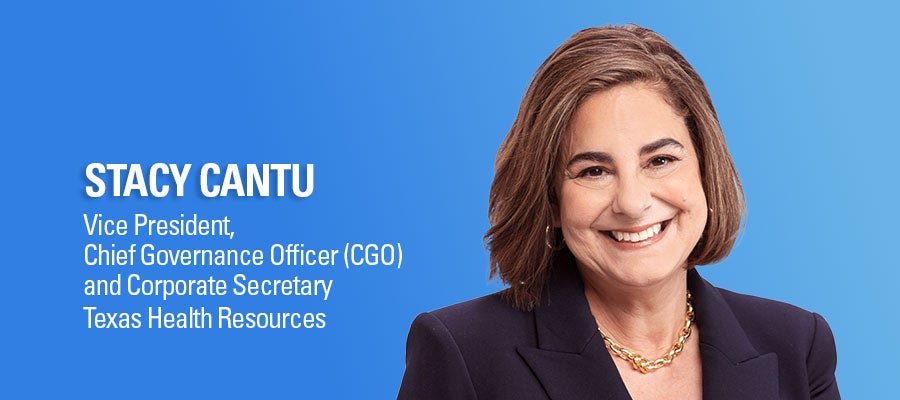
Board Support
The Role of Chief Governance Officer
Texas Health Resources’ Stacy Cantu discusses challenges including CEO turnover and technology
By Sue Ellen Wagner
Leading Board Practices
Sue Ellen Wagner, vice president, trustee engagement and strategy at the AHA, chats with Stacy Cantu, vice president, chief governance officer (CGO)and corporate secretary for Texas Health Resources about the role of a chief governance officer, challenges they may face and best practices for hospitals and health systems looking to develop this position.
Sue Ellen Wagner: Can you talk about your role in working with the Texas Health Resources Board?
Stacy Cantu: As the CGO and corporate secretary for Texas Health Resources and its subsidiary corporations, I manage all governance operations, corporate records functions and oversee policy administration. Within our department at Texas Health, we manage governance and corporate records for 75 nonprofit, for-profit and joint venture entities. Governance services include competency-based recruiting for new board and committee members; managing of data (often very confidential) on governance leaders and a board portal; orienting, onboarding and ongoing board development; and conducting board assessments.
I work very closely with the Board of Directors, especially with our CEO, Barclay Berdan, the board chair and vice chair on agenda preparation, education during board meetings, oversight of presenters and meeting preparations. A key event each year is our Governance Summit, where we bring all governance leaders of our wholly controlled entities together to participate, learn and network. Governance team members work closely with executive leadership on agenda creation, meeting planning, execution and implementation. Most importantly, I extensively communicate with our governance leaders, guaranteeing each person feels connected to our mission.
Additionally, as the corporate secretary, I have the corporate records responsibility, which includes overseeing the drafting, approval and retention of 400 sets of minutes each year; formation and dissolution of corporations; preparation of certificates of incumbency; drafting and retention of approved bylaws; and Texas Secretary of State filings. Five years ago, we added policy administration responsibilities, which include the development and retention of system documents and polices; the process management of policies and order sets; and Policy Connect system administration, support and training that is very vital to our hospital employees and management.
Wagner: I appreciate that detail. Can you talk about how the role of the Chief Governance Officer is evolving?
Cantu: The role is evolving quickly and will change drastically due to technology. The new products on the market to manage trustee data and corporate records retention will enable more efficient operations; however, they will require those in the CGO role to have technology skills and the ability to understand the increased functionality. AI will play a key role in drafting and editing minutes and board communications.
The role will also be critical as CEO turnover continues to set records each year and more first-time CEOs are assuming the helm of hospitals and health systems. The CGO is primarily a partnership with the CEO, the board and committee chairs.
With this evolution, it would be great if we could produce specific education and more specific pathways to the CGO role. We do not have that same career progression in the CGO as in other roles within health care organizations. This creates a challenge, especially during this critical time of transformation.
Wagner: What governance challenges do you see in the field that you would like to highlight to our readers?
Cantu: I can answer that in two parts. The first challenge is finding trustees and committee members who meet the competencies needed for the role. At Texas Health, we start with a job description for all board and committee members and a competency framework. This framework guides our recruiting process. We first identify competency gaps and then fill positions based on the competencies we may not already have on a particular board or committee. Over the past few years, it has been more difficult to fill positions on our Audit and Compliance Committee, and we are always looking for board members with consumer and digital expertise. Although we do not have out-of-market board members or compensate board members, we do have two subject matter experts from outside the Dallas-Fort Worth metro area serving on committees. We utilize our committees as a pipeline for board positions, as well.
The second challenge is the number of other boards our trustees serve on. Corporate boards have begun closely looking at the issue of “overboarding.” This is increasingly important in the nonprofit governance space as well. Boards and committees act when they meet; we need to ensure these governance leaders have the time and resources to serve prior to finalizing their appointment.
Wagner: What advice do you have for hospitals or health systems that are looking to develop a chief governance officer role?
Cantu: Start and do not look back. Determine what the position will look like. I advise reaching out to other health care systems with a current CGO. Additionally, consult with a national compensation specialist or recruiter, as they possess deep knowledge of comparable roles and the associated compensation. Another option to consider is to look within your organization for someone who can grow into the position. Most importantly, seek a relationship builder. Governance, at its core, involves building relationships with governance leaders, the executive team and medical staff. Beyond relationships, effective communication and discretion are essential for a successful chief governance officer.
Sue Ellen Wagner (swagner@aha.org) is vice president, trustee engagement and strategy, at the American Hospital Association.
Please note that the views of interviewees do not always reflect the views of the AHA. This interview has been edited and condensed for clarity.
